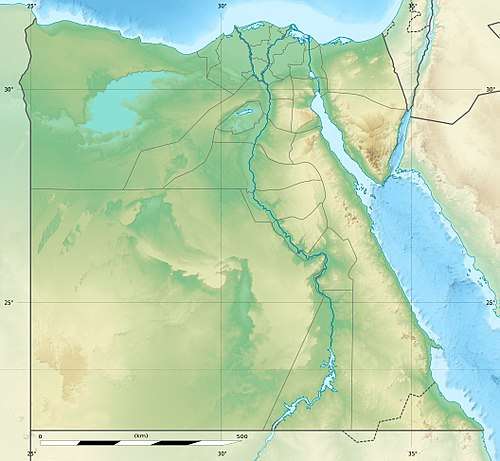Naqada III
Naqada III is the last phase of the Naqada culture of ancient Egyptian prehistory, dating from approximately 3200 to 3000 BC.[1] It is the period during which the process of state formation, which began in Naqada II, became highly visible, with named kings heading powerful polities. Naqada III is often referred to as Dynasty 0 or the Protodynastic Period[1] to reflect the presence of kings at the head of influential states, although, in fact, the kings involved would not have been a part of a dynasty. In this period, those kings' names were inscribed in the form of serekhs on a variety of surfaces including pottery and tombs.
Naqada III (Egypt) | |
| Geographical range | Egypt |
|---|---|
| Period | Early Bronze I |
| Dates | circa 3,200 B.C. – circa 3,150 B.C. |
| Major sites | Naqada |
| Preceded by | Naqada II |
| Followed by | Early Dynastic Period (Egypt) |
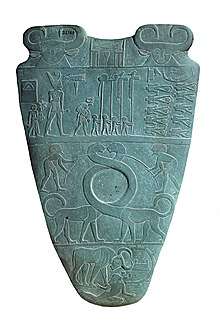
History
The protodynastic period in ancient Egypt was characterised by an ongoing process of political unification, culminating in the formation of a single state to begin the Early Dynastic Period. Furthermore, it is during this time that the Egyptian language was first recorded in hieroglyphs. There is also strong archaeological evidence of Egyptian settlements in southern Canaan during the Protodynastic Period, which are regarded as colonies or trading entrepôts.
State formation began during this era and perhaps even earlier. Various small city-states arose along the Nile. Centuries of conquest then reduced Upper Egypt to three major states: Thinis, Naqada, and Nekhen. Sandwiched between Thinis and Nekhen, Naqada was the first to fall. Thinis then conquered Lower Egypt. Nekhen's relationship with Thinis is uncertain, but these two states may have merged peacefully, with the Thinite royal family ruling all of Egypt. The Thinite kings were buried at Abydos in the Umm el-Qa'ab cemetery.
Most Egyptologists consider Narmer to be both the last king of this period and the first king of the First Dynasty. He was possibly preceded over some parts of Upper Egypt by Crocodile, Iry-Hor, Ka and perhaps by the so-called "Scorpion King(s)", whose name may refer to, or be derived from, the goddess Serket, a special early protector of other deities and the rulers.[2]
Naqada III extended all over Egypt and was characterized by some notable firsts:
- The first hieroglyphs
- The first graphical narratives on palettes
- The first regular use of serekhs
- The first truly royal cemeteries
- Possibly the first example of irrigation
And at best, a notable second:
- The invention of sail navigation[3] (independently from its prior invention in the Persian Gulf 2,000 years earlier)[4]
According to the Egypt's Ministry of Antiquities, in February, 2020, Egyptian archaeologists have uncovered 83 tombs dating back to 4,000 B.C known as Naqada III period. Various small pottery pots in different shapes and some sea shells, makeup tools, eyeliner pots, and jewels were also revealed in the burial.[5][6]
Artifacts
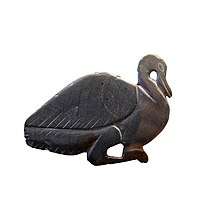 Duck-shaped palette
Duck-shaped palette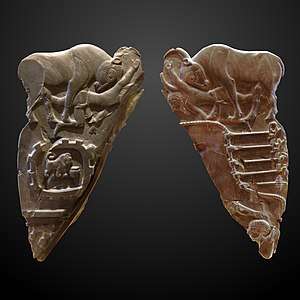 Bull plalette.
Bull plalette. The Battlefield Palette, 3100 BC.
The Battlefield Palette, 3100 BC.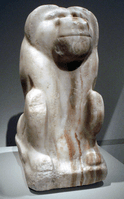 Baboon Divinity bearing name of Pharaoh Narmer on base
Baboon Divinity bearing name of Pharaoh Narmer on base
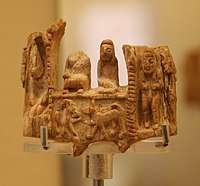 Protodynastic sceptre fragment with royal couple. Staatliche Sammlung für Ägyptische Kunst, Munich
Protodynastic sceptre fragment with royal couple. Staatliche Sammlung für Ägyptische Kunst, Munich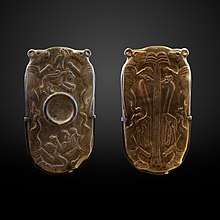 The Four Dogs Palette. Room 633 of the Louvre.
The Four Dogs Palette. Room 633 of the Louvre.
References
- Shaw 2000, p. 479.
- Shaw 2000, p. 71.
- Meza, A.I. (2007) “Neolithic Boats: Ancient Egypt and the Maltese Islands. A Minoan Connection” J-C. Goyon,C. Cardin (Eds.) Actes Du Neuvième Congrès International Des Égyptologues, p. 1287.
- Robinson, D. (2012). "Review of: Anderson, A., et al. (2010), The Global Origins and Development of Seafaring". International Journal of Nautical Archaeology. 41 (1): 206–208. doi:10.1111/j.1095-9270.2011.00333_2.x.
- February 2020, Laura Geggel-Associate Editor 21. "Dozens of ancient Egyptian graves found with rare clay coffins". livescience.com. Retrieved 2020-06-28.
- "الكشف عن 83 مقبرة أثرية بمنطقة آثار كوم الخلجان بمحافظة الدقهلية". اليوم السابع. 2020-02-12. Retrieved 2020-06-28.
Further reading
- Anđelković, Branislav (2002). "Southern Canaan as an Egyptian Protodynastic Colony". Cahiers Caribéens d'Égyptologie. 3/4 (Dix ans de hiéroglyphes au campus): 75–92.
- Bard, Katherine A. (2000). "The Emergence of the Egyptian State". In Shaw, Ian (ed.). The Oxford History of Ancient Egypt. Oxford and New York: Oxford University Press. pp. 61–88. ISBN 0-19-815034-2.
- Midant-Reynes, Béatrix (2000). The Prehistory of Egypt: From the First Egyptians to the First Pharaohs. Oxford and Malden: Blackwell. ISBN 0-631-20169-6.
- Shaw, Ian, ed. (2000). The Oxford History of Ancient Egypt. Oxford University Press. ISBN 0-19-815034-2.CS1 maint: ref=harv (link)
- Wilkinson, Toby Alexander Howard (2001). Early Dynastic Egypt (2nd ed.). London: Routledge. ISBN 0-415-18633-1.CS1 maint: ref=harv (link)
- Wright, Mary (1985). "Contacts Between Egypt and Syro-Palestine During the Protodynastic Period". Biblical Archaeologist. 48 (4): 240–53. doi:10.2307/3209960. JSTOR 3209960.
External links
| Wikimedia Commons has media related to Naqada III. |
- Naqada III: Dynasty 0
- "Unification Theories", Naqadan in Egypt, UK: UCL.
